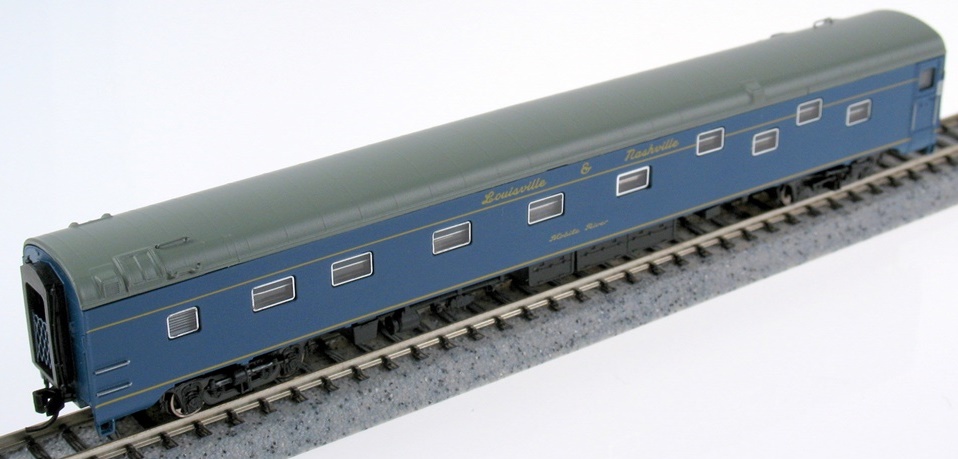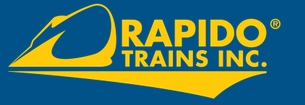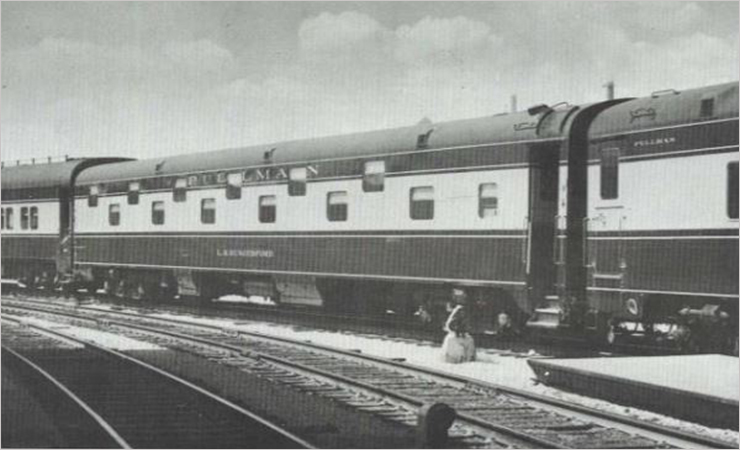Model Information: The Duplex Sleeper is available with partial skirting or with fixed steps, as appropriate.
The Duplex Sleeper is Pullman plan number 4124, a CN and Great Northern prototype with 4 sections, 8 duplex roomettes and 4 bedrooms. Several railroads throughout North America had similar duplex sleepers, and our car is painted in a variety of paint schemes.
- Super-detailed underbody
- Body-mounted Micro-Trains(r) couplers
- Fixed steps or partial skirts, as appropriate
- All air, steam and electrical lines represented Insulated 36″ metal wheelsets (no pizza cutters!)
- "Easy-Peasy" battery-powered interior lighting
- Flush windows with painted gaskets and shades
- Full interior detail including armrests and headrests
- Diaphragms with etched brass end gates
- Painted metal roof grab irons applied at the factory
- Multiple car names and/or numbers per paint scheme
- Will operate smoothly on curves down to 9-3/4″ radius
- Super-detailled 41-N-11 Inside Swinghanger or 41-BNO-11 Outside Swinghanger trucks as appropriate for each roadname and car type.
The Duplex Sleeper is Pullman plan number 4124, a CN and Great Northern prototype with 4 sections, 8 duplex roomettes and 4 bedrooms. Several railroads throughout North America had similar duplex sleepers, and our car is painted in a variety of paint schemes.
Prototype History: The Pullman plan 4124 duplex sleeper is everything you need for your overnight passengers, from your branchline, backwater mail train to your hot Limiteds. It features the three most common forms of overnight accommodation - open sections for the budget-minded, roomettes for private day and night travel, and double bedrooms with comfortable seats. Bedroom seats have see-through armrests, and roomettes have curtains for privacy. Public restrooms at the A end of the car include a vanity for the ladies and dental bowls for hygiene.
Pullman plan number 4124, was used by both the CN and Great Northern railroads. It featured 4 sections, 8 duplex roomettes and 4 bedrooms. Several railroads throughout North America had similar duplex sleepers, and this car was painted in a variety of paint schemes.
Pullman plan number 4124, was used by both the CN and Great Northern railroads. It featured 4 sections, 8 duplex roomettes and 4 bedrooms. Several railroads throughout North America had similar duplex sleepers, and this car was painted in a variety of paint schemes.
Road Name History: The Louisville and Nashville Railroad (reporting mark LN), commonly called the L&N, was a Class I railroad that operated freight and passenger services in the southeast United States.
Chartered by the Commonwealth of Kentucky in 1850, the road grew into one of the great success stories of American business. Operating under one name continuously for 132 years, it survived civil war and economic depression and several waves of social and technological change. Under Milton H. Smith, president of the company for thirty years, the L&N grew from a road with less than three hundred miles (480 km) of track to a 6,000-mile (9,700 km) system serving thirteen states. As one of the premier Southern railroads, the L&N extended its reach far beyond its namesake cities, stretching to St. Louis, Memphis, Atlanta, and New Orleans. The railroad was economically strong throughout its lifetime, operating both freight and passenger trains in a manner that earned it the nickname, "The Old Reliable."
Growth of the railroad continued until its purchase and the tumultuous rail consolidations of the 1980s which led to continual successors. By the end of 1970, L&N operated 6,063 miles (9,757 km) of road on 10,051 miles (16,176 km) of track, not including the Carrollton Railroad.
In 1971 the Seaboard Coast Line Railroad, successor to the Atlantic Coast Line Railroad, purchased the remainder of the L&N shares it did not already own, and the company became a subsidiary. By 1982 the railroad industry was consolidating quickly, and the Seaboard Coast Line absorbed the Louisville & Nashville Railroad entirely. Then in 1986, the Seaboard System merged with the C&O and B&O and the new combined system was known as the Chessie System. Soon after the combined company became CSX Transportation (CSX), which now owns and operates all of the former Louisville and Nashville lines.
Read more on Wikipedia.
Chartered by the Commonwealth of Kentucky in 1850, the road grew into one of the great success stories of American business. Operating under one name continuously for 132 years, it survived civil war and economic depression and several waves of social and technological change. Under Milton H. Smith, president of the company for thirty years, the L&N grew from a road with less than three hundred miles (480 km) of track to a 6,000-mile (9,700 km) system serving thirteen states. As one of the premier Southern railroads, the L&N extended its reach far beyond its namesake cities, stretching to St. Louis, Memphis, Atlanta, and New Orleans. The railroad was economically strong throughout its lifetime, operating both freight and passenger trains in a manner that earned it the nickname, "The Old Reliable."
Growth of the railroad continued until its purchase and the tumultuous rail consolidations of the 1980s which led to continual successors. By the end of 1970, L&N operated 6,063 miles (9,757 km) of road on 10,051 miles (16,176 km) of track, not including the Carrollton Railroad.
In 1971 the Seaboard Coast Line Railroad, successor to the Atlantic Coast Line Railroad, purchased the remainder of the L&N shares it did not already own, and the company became a subsidiary. By 1982 the railroad industry was consolidating quickly, and the Seaboard Coast Line absorbed the Louisville & Nashville Railroad entirely. Then in 1986, the Seaboard System merged with the C&O and B&O and the new combined system was known as the Chessie System. Soon after the combined company became CSX Transportation (CSX), which now owns and operates all of the former Louisville and Nashville lines.
Read more on Wikipedia.
Brand/Importer Information: Rapido Trains Inc. is a high-end manufacturer of model trains and accessories in HO, OO and N (North American 1:160 and British 1:148) scales. The firm's mission is to recreate the entire rail travel experience, from fully-detailed interiors and under-frames on models to fully-wired telephone poles for model railroads.
The name RAPIDO was introduced by Canadian National in 1965 to headline the railway's high-speed intercity passenger services. Until the mid-1980s, RAPIDO stood for fast schedules, frequent trains, and superb service.
Today, Rapido Trains continues the RAPIDO concept with state-of-the-art models and attention to fine detail. This company is not related to the venerable (and now defunct) German manufacturer Arnold Rapido, nor the present-day Arnold (which is owned by the United Kingdom's Hornby), Canadian based Rapido Trains was founded in 2003.
The name RAPIDO was introduced by Canadian National in 1965 to headline the railway's high-speed intercity passenger services. Until the mid-1980s, RAPIDO stood for fast schedules, frequent trains, and superb service.
Today, Rapido Trains continues the RAPIDO concept with state-of-the-art models and attention to fine detail. This company is not related to the venerable (and now defunct) German manufacturer Arnold Rapido, nor the present-day Arnold (which is owned by the United Kingdom's Hornby), Canadian based Rapido Trains was founded in 2003.
Item created by: Alain LM on 2016-07-17 07:07:55. Last edited by gdm on 2018-05-29 08:56:11
If you see errors or missing data in this entry, please feel free to log in and edit it. Anyone with a Gmail account can log in instantly.
If you see errors or missing data in this entry, please feel free to log in and edit it. Anyone with a Gmail account can log in instantly.











